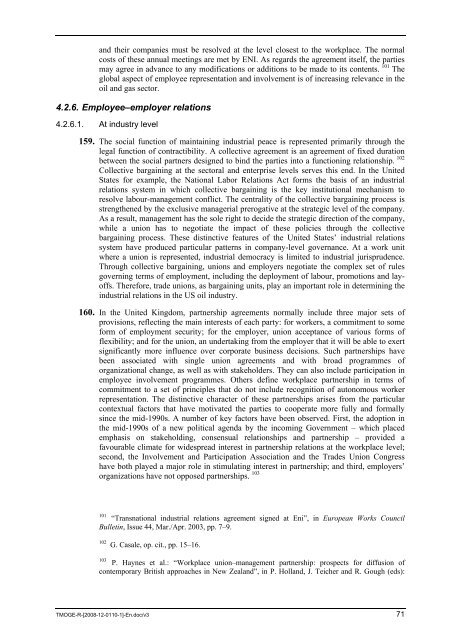wcms_161662
wcms_161662
wcms_161662
You also want an ePaper? Increase the reach of your titles
YUMPU automatically turns print PDFs into web optimized ePapers that Google loves.
and their companies must be resolved at the level closest to the workplace. The normal<br />
costs of these annual meetings are met by ENI. As regards the agreement itself, the parties<br />
may agree in advance to any modifications or additions to be made to its contents. 101 The<br />
global aspect of employee representation and involvement is of increasing relevance in the<br />
oil and gas sector.<br />
4.2.6. Employee–employer relations<br />
4.2.6.1. At industry level<br />
159. The social function of maintaining industrial peace is represented primarily through the<br />
legal function of contractibility. A collective agreement is an agreement of fixed duration<br />
between the social partners designed to bind the parties into a functioning relationship. 102<br />
Collective bargaining at the sectoral and enterprise levels serves this end. In the United<br />
States for example, the National Labor Relations Act forms the basis of an industrial<br />
relations system in which collective bargaining is the key institutional mechanism to<br />
resolve labour-management conflict. The centrality of the collective bargaining process is<br />
strengthened by the exclusive managerial prerogative at the strategic level of the company.<br />
As a result, management has the sole right to decide the strategic direction of the company,<br />
while a union has to negotiate the impact of these policies through the collective<br />
bargaining process. These distinctive features of the United States’ industrial relations<br />
system have produced particular patterns in company-level governance. At a work unit<br />
where a union is represented, industrial democracy is limited to industrial jurisprudence.<br />
Through collective bargaining, unions and employers negotiate the complex set of rules<br />
governing terms of employment, including the deployment of labour, promotions and layoffs.<br />
Therefore, trade unions, as bargaining units, play an important role in determining the<br />
industrial relations in the US oil industry.<br />
160. In the United Kingdom, partnership agreements normally include three major sets of<br />
provisions, reflecting the main interests of each party: for workers, a commitment to some<br />
form of employment security; for the employer, union acceptance of various forms of<br />
flexibility; and for the union, an undertaking from the employer that it will be able to exert<br />
significantly more influence over corporate business decisions. Such partnerships have<br />
been associated with single union agreements and with broad programmes of<br />
organizational change, as well as with stakeholders. They can also include participation in<br />
employee involvement programmes. Others define workplace partnership in terms of<br />
commitment to a set of principles that do not include recognition of autonomous worker<br />
representation. The distinctive character of these partnerships arises from the particular<br />
contextual factors that have motivated the parties to cooperate more fully and formally<br />
since the mid-1990s. A number of key factors have been observed. First, the adoption in<br />
the mid-1990s of a new political agenda by the incoming Government – which placed<br />
emphasis on stakeholding, consensual relationships and partnership – provided a<br />
favourable climate for widespread interest in partnership relations at the workplace level;<br />
second, the Involvement and Participation Association and the Trades Union Congress<br />
have both played a major role in stimulating interest in partnership; and third, employers’<br />
organizations have not opposed partnerships. 103<br />
101 “Transnational industrial relations agreement signed at Eni”, in European Works Council<br />
Bulletin, Issue 44, Mar./Apr. 2003, pp. 7–9.<br />
102 G. Casale, op. cit., pp. 15–16.<br />
103 P. Haynes et al.: “Workplace union–management partnership: prospects for diffusion of<br />
contemporary British approaches in New Zealand”, in P. Holland, J. Teicher and R. Gough (eds):<br />
TMOGE-R-[2008-12-0110-1]-En.doc/v3 71














